Deploy SAP HANA Scale-Up Appliance with Cisco UCS X-Series Modular System
Available Languages
Bias-Free Language
The documentation set for this product strives to use bias-free language. For the purposes of this documentation set, bias-free is defined as language that does not imply discrimination based on age, disability, gender, racial identity, ethnic identity, sexual orientation, socioeconomic status, and intersectionality. Exceptions may be present in the documentation due to language that is hardcoded in the user interfaces of the product software, language used based on RFP documentation, or language that is used by a referenced third-party product. Learn more about how Cisco is using Inclusive Language.
Organizations in every industry are generating and using more data than ever before, from customer transactions and supplier delivery details to real-time user-consumption statistics and much more. Without reliable infrastructure that can store, process, and analyze big data sets in real time, organizations cannot use this information to their advantage. Cisco and SAP offer a solution.
The Cisco® solution for SAP HANA using the high-performance Cisco UCS® X-Series Modular System is well-suited for mission-critical business scenarios with SAP HANA database implementations. It provides a robust platform for SAP HANA workloads in a single-node (scale-up) configuration.
SAP HANA provides a database with advanced analytical capabilities and intuitive application-development tools in an in-memory data platform. The scale-up solution for SAP HANA with the Cisco UCS X-Series is a prevalidated approach for deploying SAP HANA scale-up systems that offers the advantages of simplified management, lower deployment risk, and reduced total cost of ownership (TCO).
This section introduces the SAP HANA on Cisco UCS X-Series Modular System solution.
The SAP HANA in-memory database combines transactional and analytical SAP workloads, taking advantage of the low-cost main memory, data processing capabilities of multicore processors, and faster data access.
The Cisco UCS X-Series is a brand-new modular computing system, configured and managed from the cloud. It is designed to meet the needs of modern applications and to improve operational efficiency, agility, and scale through an adaptable, future-ready, modular design. The Cisco UCS X-Series is equipped with the third-generation (3rd Gen) Intel® Xeon™ scalable processors, and it supports DDR4-only memory modules or a mixture with Intel Optane Persistent Memory. The Cisco Intersight™ platform is a software-as-a-service (SaaS) infrastructure lifecycle management platform that delivers simplified configuration, deployment, maintenance, and support.
The solution combines Cisco hardware and software components optimized for SAP HANA workloads as preconfigured and validated architecture. The Cisco UCS X-Series solution is certified as a SAP HANA appliance with various memory size options. The standard configuration enables the server for SAP HANA Tailored Datacenter Integration (TDI) deployments. SAP HANA TDI allow organizations to run multiple SAP HANA instances on shared infrastructure. It also allows customers to run SAP application servers and the SAP HANA database hosted on the same infrastructure.
Powered by the Cisco Intersight cloud-operations platform, the Cisco UCS X-Series enables the next-generation cloud-operated infrastructure that simplifies data center management. With the Cisco Intersight platform, customers get all the benefits of SaaS delivery and the full lifecycle management of servers connected through the Cisco Intersight platform.
The intended audience for this document includes IT architects, sales engineers, field consultants, professional services, IT managers, partner engineering, and customers who want to deploy SAP HANA on the Cisco UCS X-Series Modular System. External references are provided wherever applicable, but readers are expected to be familiar with the technology, infrastructure, and database security policies of the customer installation.
The document provides high-level steps for deploying and configuring SAP HANA on the Cisco UCS X-Series Modular System. It presents this Cisco solution for SAP HANA based on either of two supported Linux operating systems: SUSE Linux Enterprise Server (SLES) for SAP Applications 15 and Red Hat Enterprise Linux (RHEL) 8. Although readers of this document are expected to have access to the knowledgebases of Red Hat, SUSE, and SAP and sufficient knowledge to install and configure the products used, configuration details important to this solution deployment are provided.
The Cisco UCS X210c M6 Compute Node is part of the new Cisco UCS X-Series Modular System. The Cisco UCS X210c M6 for SAP HANA scale-up solution is prevalidated with local storage technology. It comprises a defined set of hardware and software that serves as an integrated foundation for nonvirtualized workloads.
All components are connected and configured according to best practices of Cisco, Red Hat, SUSE, and SAP SE. The Cisco UCS X210c M6 Compute Node data sheet summarizes the server specifications, and Table 1 shows the proposed configurations specific to SAP HANA use cases.
Table 1. Cisco UCS X210c M6 server configuration for SAP HANA scale-up system
|
|
|
Quantity |
DDR4 capacity |
Usable capacity |
| CPU specifications |
Intel Xeon Platinum 8368 or 8380 processor |
2 |
|
|
| Possible memory configurations * (32 DIMM slots; 16 DIMMs per CPU) |
16-GB DDR4 32-GB DDR4 64-GB DDR4 128-GB DDR4 |
16 16 / 32 32 32 |
256 GB 512 GB / 1TB 2 TB 4 TB |
|
| Internal storage for SAP HANA volumes (Up to 6 SAS/SATA/NVMe disk drives) |
3.8-TB SAS SSD
7.6-TB SAS SSD |
4 disks (RAID 5) |
Up to 2 TB
Up to 4 TB |
10.4 TB
20.7 TB |
In addition, the Cisco UCS X-Series provides these features:
· Cisco UCS Virtual Interface Card (VIC) 14425 modular LAN on motherboard (mLOM), with two ports supporting 25 Gbps
· Optional one rear mezzanine slot for the two-port 25-Gbps VIC 14825
· One front mezzanine slot initially for a Cisco FlexStorage RAID controller or Cisco FlexStorage passthrough with additional future options
· Up to two M.2 drives with hardware RAID support that can be used for OS installation
This section provides a technical overview of the compute and storage components and the solution requirements important for SAP HANA operation in this environment.
The baseline server configuration uses two RAID controllers. One 12-GBps MegaRAID SAS controller manages two M.2 internal RAID 1 protected SAS drives to the host operating system. A second 12-GBps MegaRAID SAS controller manages from four to six internal, RAID 5 protected and hot-swappable SAS solid-state disks (SSDs) that host the persistent data of the SAP HANA database. The Cisco UCS VIC 14425 occupies the server’s mLOM slot and provides up to 50 Gbps of unified fabric connectivity to each of the chassis’ Cisco UCS X-Series Intelligent Fabric Modules (IFMs), for 100-Gbps connectivity per server.
Several hardware and software requirements must be fulfilled before you set up and install an SAP HANA server. SAP increases flexibility and allows alternative configurations to the SAP HANA appliances with the six phases of SAP HANA TDI, which are described in SAP HANA Tailored Data Center Integration – Overview.
CPU architecture
The dual-socket Cisco UCS X210c server is available with 3rd Gen Intel Xeon Scalable Platinum processors: either the 8368 or the 8380 processor with 38 or 40 cores per CPU socket, respectively. Both CPU models are certified for SAP HANA use in an appliance configuration. SAP HANA TDI implementations can also use other Intel Xeon 8000 series and 6000, 5000, and 4000 series processors.
Memory platform support
SAP HANA supports the following DDR4 DRAM memory configurations:
● SAP HANA 2.0 memory up to 2 TB for SAP NetWeaver Business Warehouse (BW) and DataMart.
● SAP HANA 2.0 memory up to 4 TB for SAP Business Suite on SAP HANA (SoH)
Operating system
The Cisco X210c M6 server is certified for SAP HANA starting with the RHEL for SAP Solutions 8.2 and SLES for SAP Applications 15 SP2 operating system releases. To evaluate the compatibility of Linux operating system releases and SAP HANA platform releases, refer to SAP Note 2235581: SAP HANA: Supported Operating Systems.
Figure 1 shows the file system layout for an SAP HANA installation. Refer to OS-specific recommendations when defining the file system sizes for /boot, /boot/efi, / and the swap file; see SAP Note 2578899: SUSE Linux Enterprise Server 15: Installation Note and SAP Note 2772999: Red Hat Enterprise Linux 8.x: Installation and Configuration as appropriate.
Figure 1. Proposed disk layout with partition mapping for four-SSD (both 3.8-TB SSDs and 7.6-TB SSDs) configurations
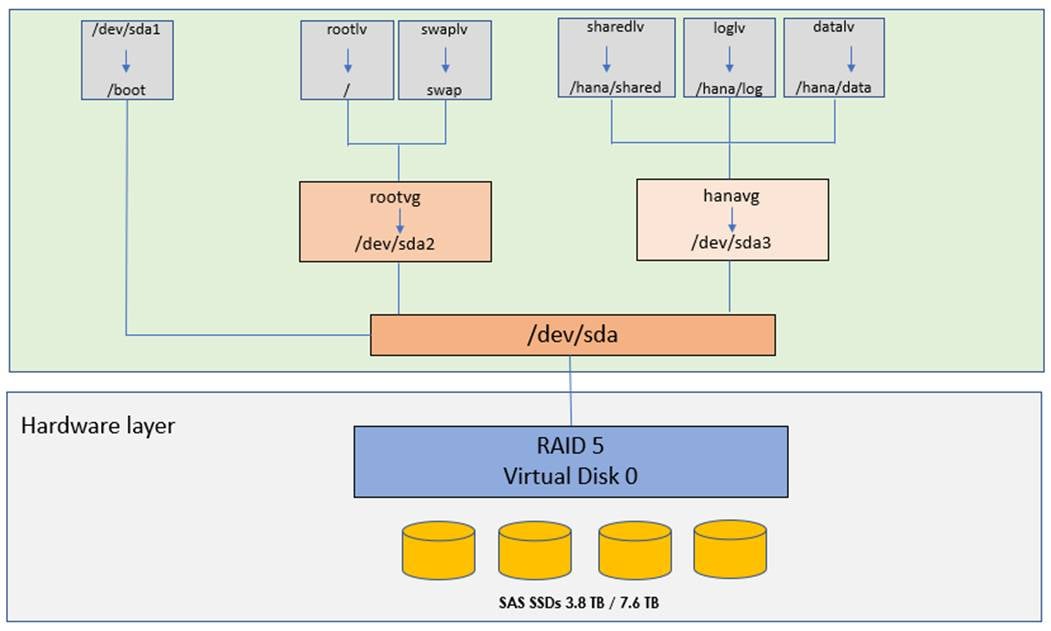
Disk size and file system requirements
For SAP HANA persistence partitions, you should consult the recommendations for SAP HANA storage requirements when you configure the SAP HANA data, log, and shared directories. If no application-specific sizing data is available, the recommended size for the SAP HANA volumes is directly related to the total memory required for the system.
For example, for an SAP HANA scale-up appliance with 4-TB of main memory, the recommended SAP HANA file system sizes are as follows:
● /hana/data = 3 x memory = 3 x 4 TB = 12 TB
● /hana/log = 512 GB
● /hana/shared = 1 x memory = 4 TB
Server hardware configuration
It is beyond the scope of this document to explain the installation and connection of the Cisco Unified Computing System™ (Cisco UCS) infrastructure. All physical hardware must be racked according to the specific hardware installation guides: Cisco UCS X-Series Quick Start Guide and Meet the UN/BOX: Cisco UCS X-Series Modular System with Intersight Solution Overview
Cisco UCS X-Series Modular System overview
The Cisco UCS X-Series Modular System is designed to take the current generation of the Cisco UCS platform to the next level with its future-ready design and cloud-based management. Decoupling platform management and moving it to the cloud allows Cisco UCS to respond to customer feature and scalability requirements much faster and more efficiently. The Cisco UCS X-Series state-of-the-art hardware simplifies the data center design by providing flexible server options. A single node type, supporting a broader range of workloads, results in fewer different data center products to manage and maintain. The Cisco Intersight cloud-management platform manages the Cisco UCS X-Series and also integrates with third-party devices, including VMware vCenter and NetApp storage. It thus provides visibility, optimization, and orchestration from a single platform, thereby increasing agility and deployment consistency.
Figure 2. Cisco UCS X9508 Server Chassis
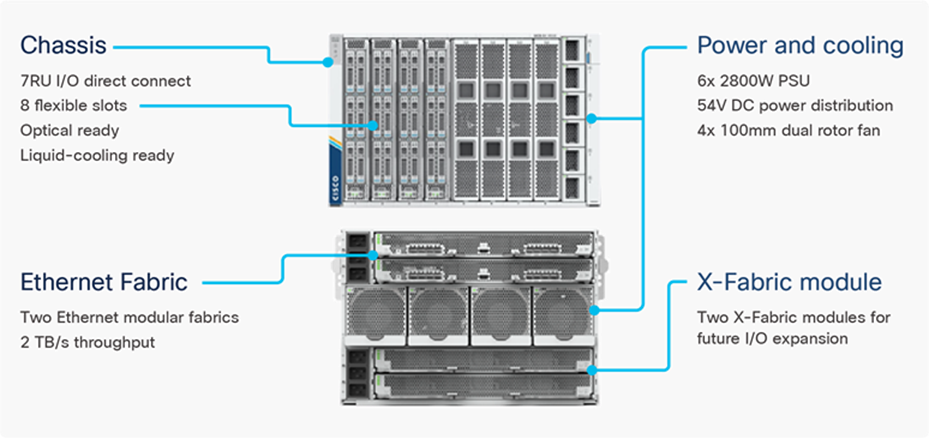
The following sections describe the Cisco UCS X-Series components.
Cisco UCS X9508 Server Chassis
The Cisco UCS X-Series chassis is designed to be adaptable and flexible. As shown in Figure 2, Cisco UCS X9508 chassis has only a power-distribution midplane. This midplane-free design (Figure 3) presents fewer obstructions, for better airflow. For I/O connectivity, vertically oriented compute nodes intersect with horizontally oriented fabric modules, allowing the chassis to support future fabric innovations. The Cisco UCS X9508 chassis’ superior packaging enables larger compute nodes, thereby providing more space for actual computing components, such as memory, graphics processing units (GPUs), drives, and accelerators. Improved airflow through the chassis enables support for higher-power components, and more space allows for future thermal solutions (such as liquid cooling) without limitations.
Figure 3. Cisco UCS X9508 Server Chassis: Midplane-free design
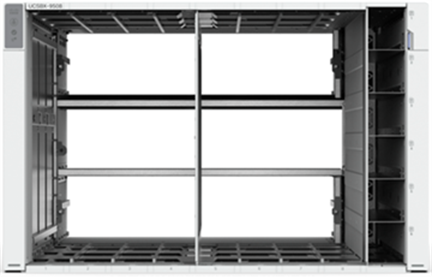
The Cisco UCS X9508 is a 7-rack-unit (7RU) chassis offering eight flexible slots. These slots can house a combination of compute nodes and a pool of future I/O resources that may include GPU accelerators, disk storage, and nonvolatile memory. At the top rear of the chassis are two IFMs that connect the chassis to upstream Cisco UCS 6400 Series Fabric Interconnects. At the bottom rear of the chassis are slots ready to house future X-Fabric modules that can flexibly connect the compute nodes with I/O devices. Six 2800-watt (W) power supply units (PSUs) provide 54-volt (V) power to the chassis with N, N+1, and N+N redundancy. A higher voltage allows efficient power delivery with less copper and reduced power loss. Efficient, 100-mm, dual counter-rotating fans deliver industry-leading airflow and power efficiency, and optimized thermal algorithms enable the use of different cooling modes to best support the customer’s environment.
Cisco UCS 9108 25G Intelligent Fabric Modules
For the Cisco UCS X9508 chassis, the network connectivity is provided by a pair of Cisco UCS 9108 25G IFMs (Figure 4). Like the fabric extenders used in the Cisco UCS 5108 Blade Server Chassis, these modules carry all network traffic to a pair of Cisco UCS 6400 Series Fabric Interconnects. IFMs also host the chassis management controller (CMC) for chassis management. In contrast to systems with fixed networking components, the Cisco UCS X9508 uses a midplane-free design. This design enables easy upgrades to new networking technologies as they emerge and straightforward accommodation of new network speeds and technologies in the future.
Figure 4. Cisco UCS 9108 25G Intelligent Fabric Module

Each IFM supports eight 25-Gbps uplink ports for connecting the Cisco UCS X9508 chassis to the fabric interconnects and thirty-two 25-Gbps server ports for the eight compute nodes. IFM server ports can provide up to 200 Gbps of unified fabric connectivity per compute node across the two IFMs. The uplink ports connect the chassis to the Cisco UCS fabric interconnects, providing up to 400-Gbps connectivity across the two IFMs. The unified fabric carries management, virtual machine, and Fibre Channel over Ethernet (FCoE) traffic to the fabric interconnects. There, management traffic is routed to the Cisco Intersight cloud operations platform, FCoE traffic is forwarded to the native Fibre Channel interfaces through unified ports on the fabric interconnects (to Cisco MDS 9000 Family switches), and data Ethernet traffic is forwarded upstream to the data center network (through Cisco Nexus® Family switches).
Cisco UCS X210c M6 Compute Node
The Cisco UCS X9508 chassis is designed to host up to eight Cisco UCS X210c M6 Compute Nodes. The hardware details of the Cisco UCS X210c M6 Compute Nodes are shown in Figure 5.
Figure 5. Cisco UCS X210c M6 Compute Node
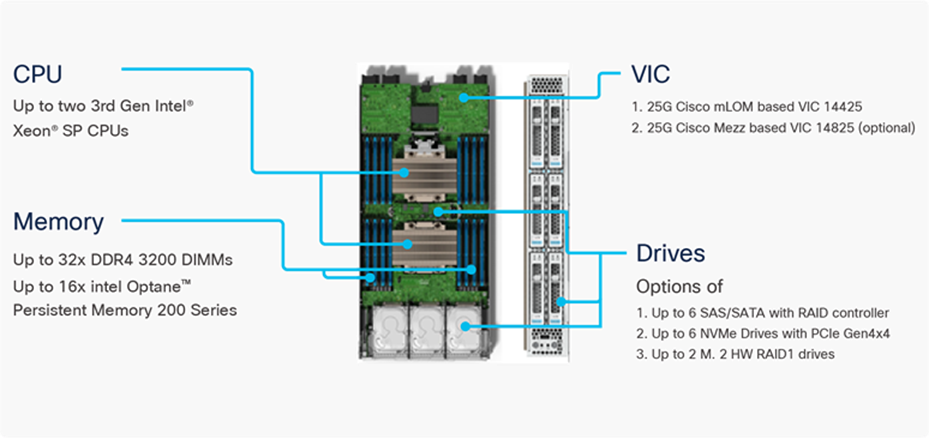
Cisco UCS virtual interface cards
Cisco UCS X210c M6 Compute Nodes support two Cisco fourth-generation VICs.
Cisco UCS VIC 14425
The Cisco UCS VIC 14425 (Figure 6) fits the mLOM slot in the Cisco X210c Compute Node and enables up to 50 Gbps of unified fabric connectivity to each of the chassis IFMs, for a total of 100 Gbps of connectivity per server. Cisco UCS VIC 14425 connectivity to the IFM and to the fabric interconnects is delivered through four 25-Gbps connections, which are configured automatically as two 50-Gbps port channels. The Cisco UCS VIC 14425 supports 256 virtual interfaces (both Fibre Channel and Ethernet) along with the latest networking innovations such as Non-Volatile Memory Express over Fabrics (NVMeoF) over RDMA (ROCEv2), VXLAN and NVGRE offload, and so on.
Figure 6. Single Cisco UCS VIC 14425 in Cisco UCS X210c M6
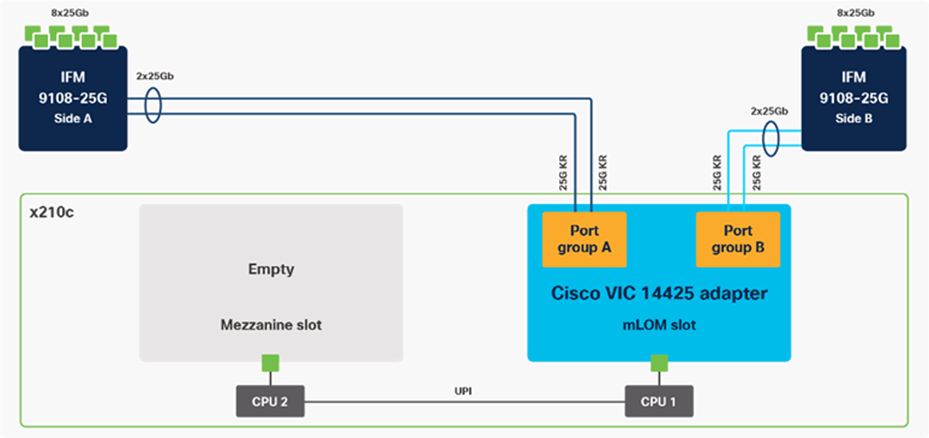
Cisco UCS VIC 14825
The optional Cisco UCS VIC 14825 (Figure 7) fits the mezzanine slot on the server. A bridge card (UCSX-V4-BRIDGE) extends this VIC’s two 50 Gbps of network connections to the mLOM slot and out through the mLOM’s IFM connectors, bringing the total bandwidth to 100 Gbps per fabric, for a total bandwidth of 200 Gbps per server.
Figure 7. Cisco VIC 14425 and 14825 in Cisco UCS X210c M6
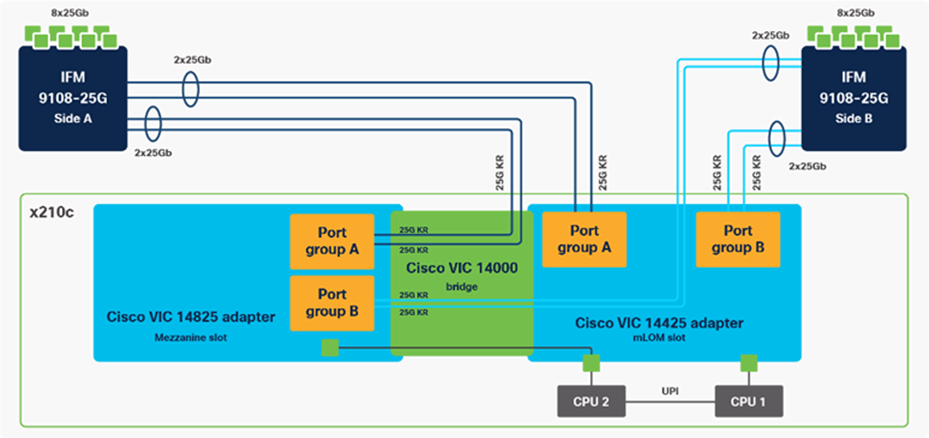
Cisco UCS 6400 Series Fabric Interconnects
The Cisco UCS fabric interconnects provide a single point for connectivity and management for the entire Cisco UCS deployment. Typically deployed as an active-active pair, the system’s fabric interconnects integrate all components into a single, highly available management domain controlled by the Cisco UCS Manager or Cisco Intersight platform. Cisco UCS fabric interconnects provide a single unified fabric for the system, with low-latency, lossless, cut-through switching that supports LAN, SAN, and management traffic using a single set of cables.
Figure 8. Cisco UCS 6454 Fabric Interconnect
![]()
Cisco UCS 6454 Fabric Interconnect (Figure 8) used in the current design is a 54-port fabric interconnect. This 1RU device includes 28 x 10/25 Gbps Ethernet ports, 4 x 1/10/25-Gbps Ethernet ports, 6 x 40/100-Gbps Ethernet uplink ports, and 16 unified ports that can support 10/25 Gigabit Ethernet or 8/16/32-Gbps Fibre Channel, depending on the Small Form-Factor Pluggable (SFP) design.
Note: To support the Cisco UCS X-Series, the fabric interconnects must be configured in Cisco Intersight managed mode (often referred to as IMM). This option replaces the local management with Cisco Intersight cloud- or appliance-based management.
The Cisco Intersight platform (Figure 9) is a SaaS infrastructure lifecycle management platform that delivers simplified configuration, deployment, maintenance, and support. The Cisco Intersight platform is designed to be modular, so customers can adopt services based on their individual requirements. The platform significantly simplifies IT operations by bridging applications with infrastructure, providing visibility and management from bare-metal servers and hypervisors to serverless applications, thereby reducing costs and mitigating risk. This unified SaaS platform uses a unified Open API design that natively integrates with third-party platforms and tools.
Figure 9. Cisco Intersight overview
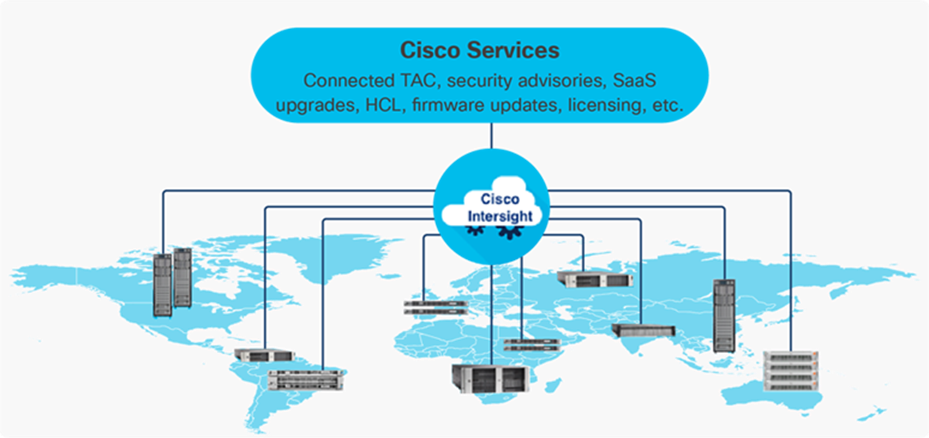
The main benefits of Cisco Intersight infrastructure services are as follows:
● Simplify daily operations by automating many daily manual tasks.
● Combine the convenience of a SaaS platform with the capability to connect from anywhere and manage infrastructure through a browser or mobile app.
● Stay ahead of problems and accelerate trouble resolution through advanced support capabilities.
● Gain global visibility of infrastructure health and status along with advanced management and support capabilities.
● Upgrade to add workload optimization and Kubernetes services when needed.
Cisco Intersight Virtual Appliance and Private Virtual Appliance
In addition to the SaaS deployment model running on Intersight.com, on-premises options can be purchased separately. The Cisco Intersight Virtual Appliance and Cisco Intersight Private Virtual Appliance are available for organizations that have additional data locality or security requirements for managing systems. The Cisco Intersight Virtual Appliance delivers the management features of the Cisco Intersight platform in an easy-to-deploy VMware Open Virtualization Appliance (OVA) or Microsoft Hyper-V Server virtual machine that allows you to control the system details that leave your premises. The Cisco Intersight Private Virtual Appliance is provided in a form factor specifically designed for users who operate in disconnected (air gap) environments. The Private Virtual Appliance requires no connection to public networks or back to Cisco to operate.
Cisco Intersight Assist
Cisco Intersight Assist helps customers add endpoint devices to Cisco Intersight. A data center could have multiple devices that do not connect directly with Cisco Intersight. Any device that is supported by Cisco Intersight, but does not connect directly with it, will need a connection mechanism. Cisco Intersight Assist provides that connection mechanism.
Cisco Intersight Assist is available within the Cisco Intersight Virtual Appliance, which is distributed as a deployable virtual machine contained within an Open Virtual Appliance (OVA) file format.
Licensing requirements
The Cisco Intersight platform uses a subscription-based license with multiple tiers. Customers can purchase a subscription duration of one, three, or five years and choose the required Cisco UCS server volume tier for the selected subscription duration. Each Cisco endpoint automatically includes a Cisco Intersight Base license at no additional cost when customers access the Cisco Intersight portal and claim a device. Customers can purchase any of the following higher-tier Cisco Intersight licenses using the Cisco ordering tool:
● Cisco Intersight Essentials: Essentials includes all the functions of the Base license plus additional features, including Cisco UCS Central Software and Cisco Integrated Management Controller (IMC) supervisor entitlement, policy-based configuration with server profiles, firmware management, and evaluation of compatibility with the Cisco Hardware Compatibility List (HCL).
● Cisco Intersight Advantage: Advantage offers all the features and functions of the Base and Essentials tiers. It includes storage widgets and cross-domain inventory correlation across compute, storage, and virtual environments (VMware ESXi). It also includes OS installation for supported Cisco UCS platforms.
● Cisco Intersight Premier: In addition to all the functions provided with the Advantage tier, Premier includes full subscription entitlement for Cisco Intersight Orchestrator, which provides orchestration across Cisco UCS and third-party systems.
Servers in Cisco Intersight managed mode require at least the Essentials license. For more information about the features provided in the various licensing tiers, see https://intersight.com/help/getting_started#licensing_requirements.
View the current Cisco Intersight Infrastructure Service licensing.
The SAP HANA scale-up solution with the Cisco UCS X-Series and the Cisco Intersight platform delivers cloud-managed infrastructure on the latest Cisco UCS hardware. The Cisco Intersight cloud-management platform is used to configure and manage the infrastructure. The solution requirements and design details are covered in this section.
The Cisco UCS X9508 chassis is equipped with Cisco UCS 9108 25G IFMs. A sample configuration of the Cisco UCS X9508 chassis connected to each Cisco UCS 6454 Fabric Interconnect using four 25 Gigabit Ethernet ports is shown in Figure 10. If you need more bandwidth, all eight ports on the IFMs can be connected to each fabric interconnect. Cisco UCS 6454 Fabric Interconnects are connected to uplink switches, with connections configured as virtual port channels.
Figure 10. Cisco UCS X9508 chassis connectivity to Cisco UCS fabric interconnects
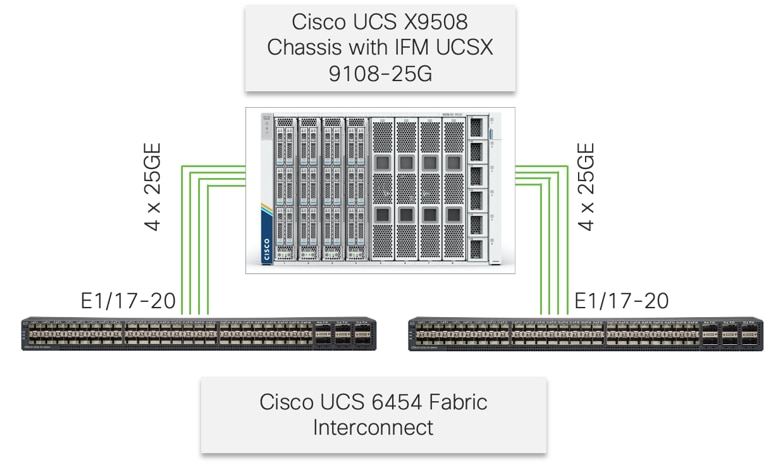
Cisco UCS X-Series configuration: Cisco Intersight managed mode
Cisco Intersight managed mode standardizes policy and operation management for the Cisco UCS X-Series. The compute nodes in the Cisco UCS X-Series are configured using server profiles defined in the Cisco Intersight platform. These server profiles derive all the server characteristics from various policies and templates. At a high level, configuring Cisco UCS using Cisco Intersight managed mode consists of the steps shown in Figure 11.
Figure 11. Configuration steps for Cisco Intersight managed mode

Set up Cisco UCS fabric interconnect for Cisco Intersight managed mode
During the initial configuration, for the management mode the configuration wizard enables customers to choose whether to manage the fabric interconnect through Cisco UCS Manager or the Cisco Intersight platform. Customers can switch the management mode for the fabric interconnects between Cisco Intersight and Cisco UCS Manager at any time; however, Cisco UCS fabric interconnects must be set up in Cisco Intersight managed mode (or IMM) to configure the Cisco UCS X-Series system. Figure 12 shows the dialog box during initial configuration of the Cisco UCS fabric interconnects to set up Cisco Intersight managed mode.
Figure 12. Fabric interconnect setup for Cisco Intersight managed mode
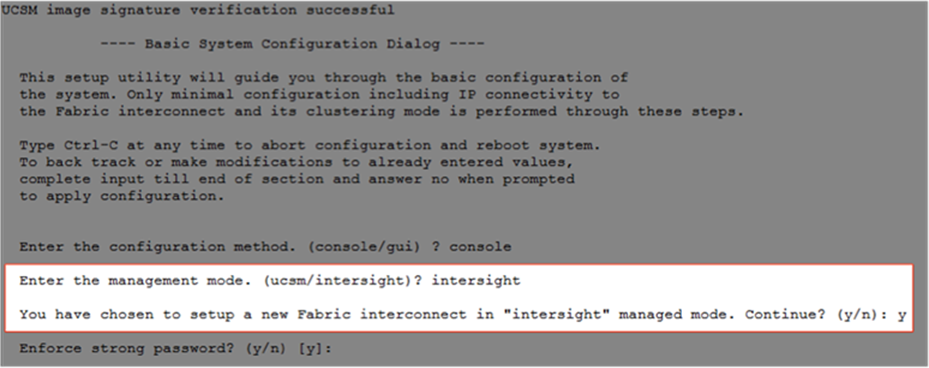
Claim a Cisco UCS fabric interconnect in the Cisco Intersight platform
After the Cisco UCS fabric interconnect is set for Cisco Intersight managed mode, fabric interconnects can be claimed to a new or an existing Cisco Intersight account (Figure 13). When a Cisco UCS fabric interconnect is successfully added to the Cisco Intersight platform, all future configuration steps are completed in the Cisco Intersight portal.
Figure 13. Cisco Intersight platform: Adding fabric interconnects
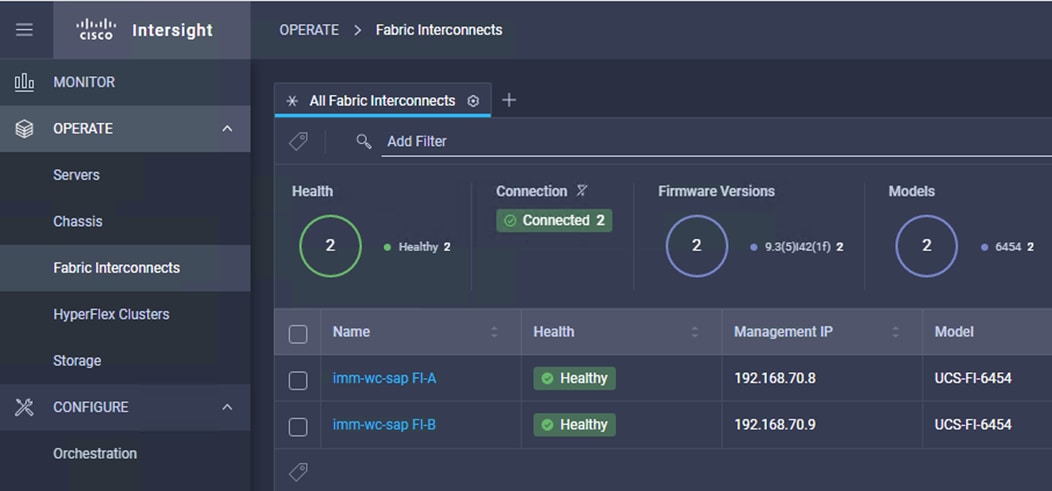
Customers can verify whether a Cisco UCS fabric interconnect is in Cisco UCS Manager managed mode or Cisco Intersight managed mode by clicking the fabric interconnect name and looking at the detailed information screen for the fabric interconnect, as shown in Figure 14.
Figure 14. Cisco UCS fabric interconnect in Cisco Intersight managed mode
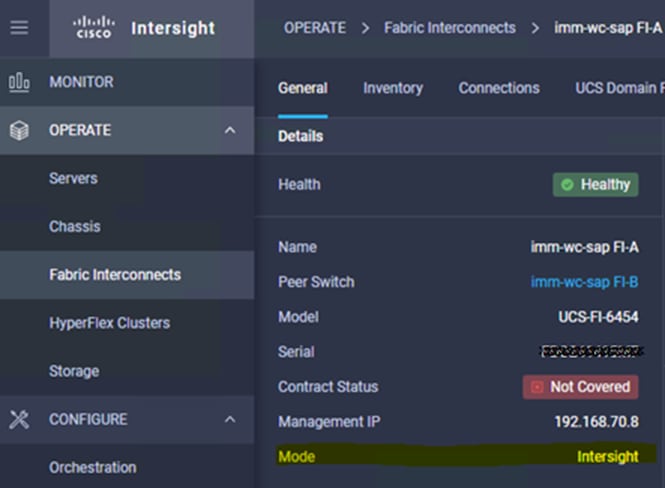
Configure Cisco UCS chassis profile
A Cisco UCS chassis profile configures and associates chassis policy with a chassis claimed in Cisco Intersight managed mode. The chassis profile feature is available in the Cisco Intersight platform only if customers have installed the Cisco Intersight Essentials license. The chassis-related policies can be attached to the profile either at the time of creation or later.
The chassis profile shown in Figure 15 is used to set the power policy for the chassis. By default, Cisco UCS X-Series power supplies are configured in Grid mode, but the power policy can be used to set the power supplies in nonredundant or N+1 or N+2 redundant modes.
Figure 15. Chassis profile
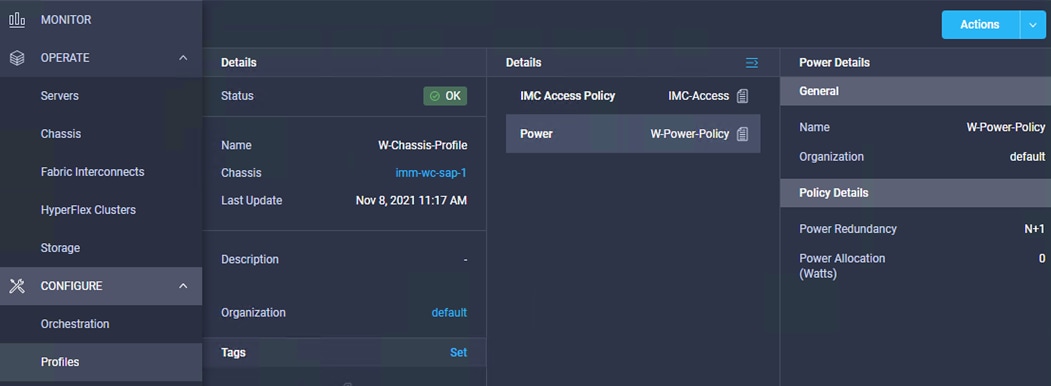
Configure Cisco UCS domain profile
A Cisco UCS domain profile configures a fabric interconnect pair through reusable policies, allows configuration of the ports and port channels, and configures the VLANs to be used in the network (Figure 16). It defines the characteristics of and configures the ports on the fabric interconnects. One Cisco UCS domain profile can be assigned to one fabric interconnect domain, and the Cisco Intersight platform supports the attachment of one port policy per Cisco UCS domain profile.
Some of the characteristics of the Cisco UCS domain profile in the SAP HANA environment are listed here:
● A single domain profile is created for a pair of Cisco UCS fabric interconnects.
● Unique port policies are defined for the two fabric interconnects.
● The VLAN configuration policy is common to the fabric interconnect pair because both fabric interconnects are configured for the same set of VLANs.
● The Network Time Protocol (NTP), network connectivity, and system quality-of-service (QoS) policies are common to the fabric interconnect pair.
After the Cisco UCS domain profile has been successfully created and deployed, the policies, including the port policies, are pushed to the Cisco UCS fabric interconnects. The Cisco UCS domain profile can easily be cloned to install additional Cisco UCS systems. When you clone the UCS domain profile, the new Cisco UCS domains use the existing policies for consistent deployment of additional Cisco UCS systems at scale.
Figure 16. Cisco UCS domain profile
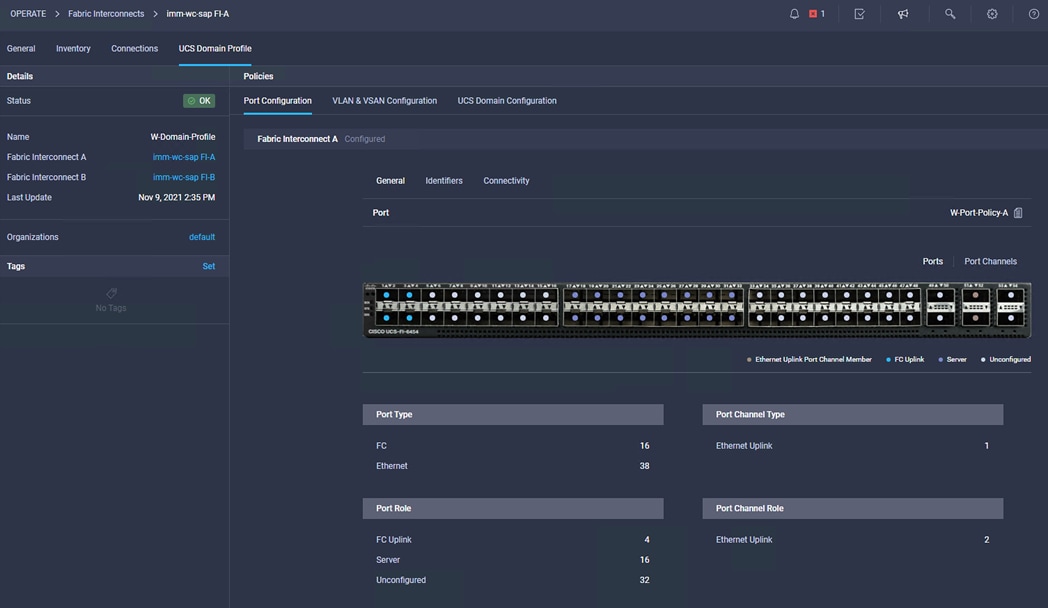
The Cisco UCS X9508 chassis and Cisco UCS X210c M6 Compute Nodes are automatically discovered when the ports are successfully configured using the domain profile, as shown in Figure 17, Figure 18, and Figure 19.
Figure 17. Cisco UCS X9508 Server Chassis (front view)
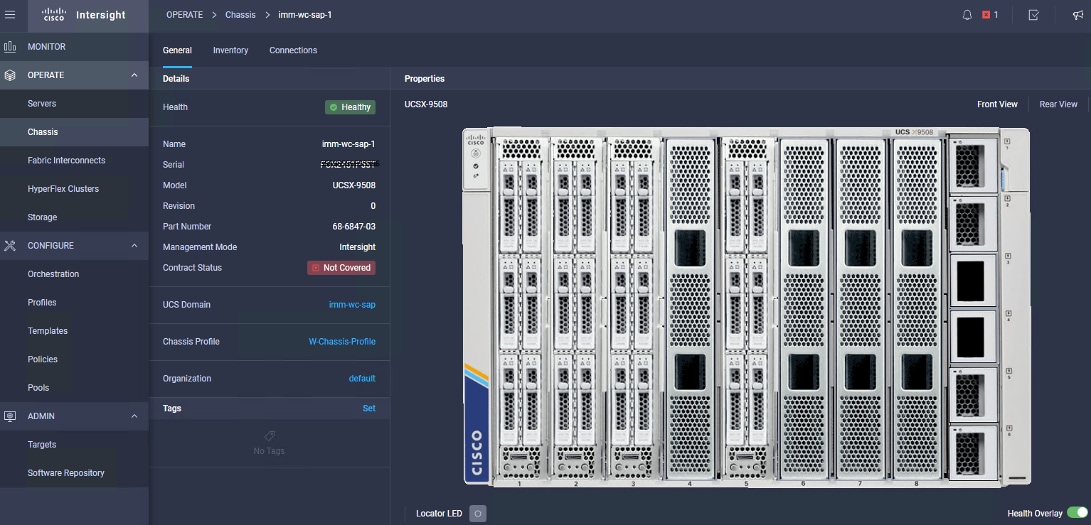
Figure 18. Cisco UCS X9508 Server Chassis (rear view)
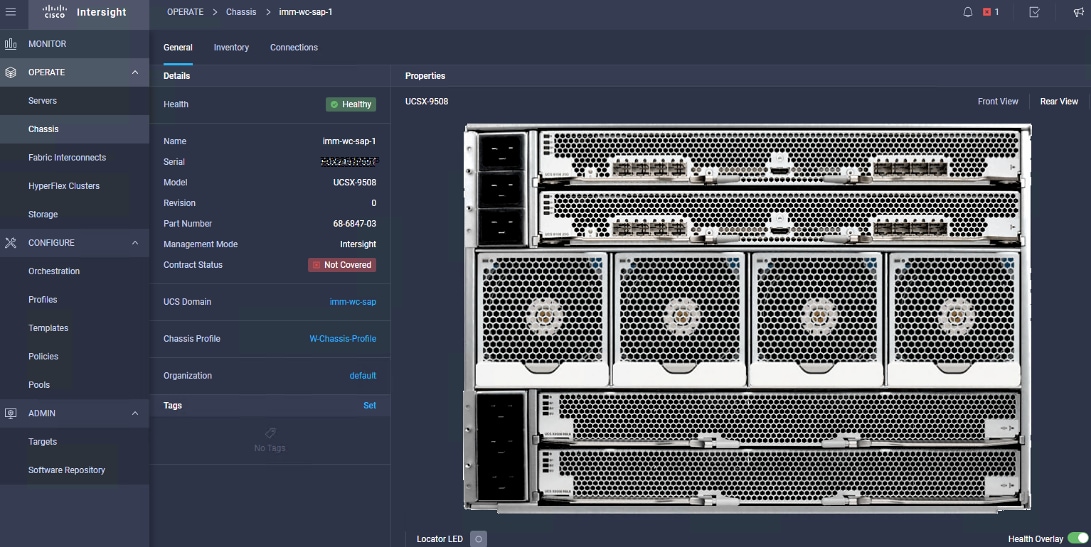
Figure 19. Cisco UCS X210c M6 Compute Nodes
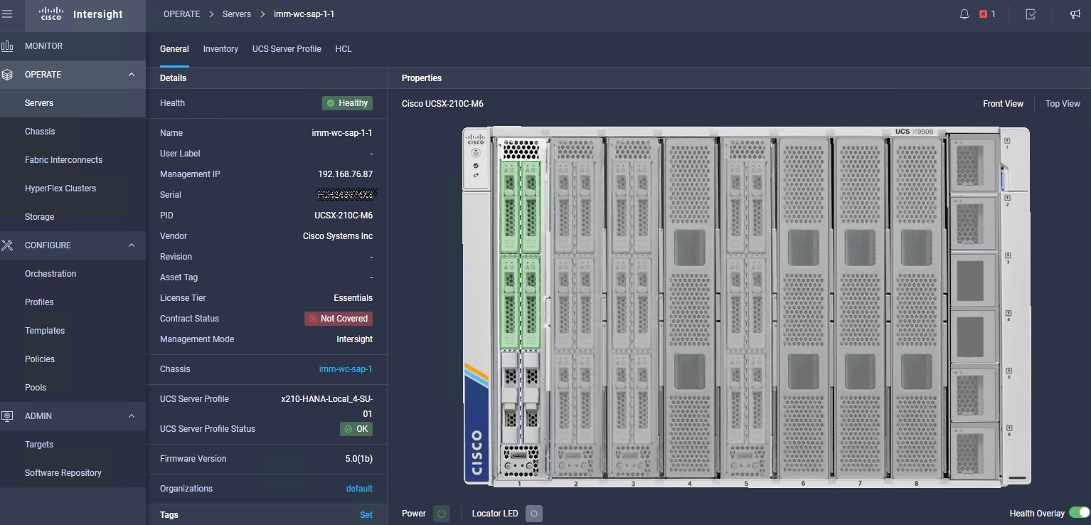
Configure server profile template
A server profile template enables resource management by simplifying policy alignment and server configuration. A server profile template is created using the server profile template wizard. The server profile template wizard groups the server policies into the following four categories to provide a quick summary view of the policies that are attached to a profile:
● Compute policies: BIOS, boot order, and virtual media policies
● Network policies: Adapter configuration, LAN connectivity, and SAN connectivity policies
◦ The LAN connectivity policy requires you to create Ethernet network policy, Ethernet adapter policy, and Ethernet QoS policy.
◦ The SAN connectivity policy is not used.
● Storage policies: For using the configured local drives
● Management policies: Intelligent Platform Management Interface (IPMI) over LAN, local user, network connectivity, Simple Network Management Protocol (SNMP), Secure Shell (SSH), Serial over LAN (SOL), and virtual keyboard, video, and mouse (vKVM) policies
Some of the characteristics of the server profile template for SAP HANA are as follows:
● BIOS policy is created to specify various server parameters in accordance with SAP HANA as detailed in relevant SAP Notes.
● Boot-order policy defines the Unified Extensible Firmware Interface (UEFI) mode to enable virtual media (KVM mapper DVD) and local disk devices.
● IMC access policy defines the management IP address pool for KVM access.
● Local user policy is used to enable KVM-based user access.
Figure 20 shows various policies associated with the server profile template.
Figure 20. Server profile template for Cisco UCS X210c based SAP HANA nodes
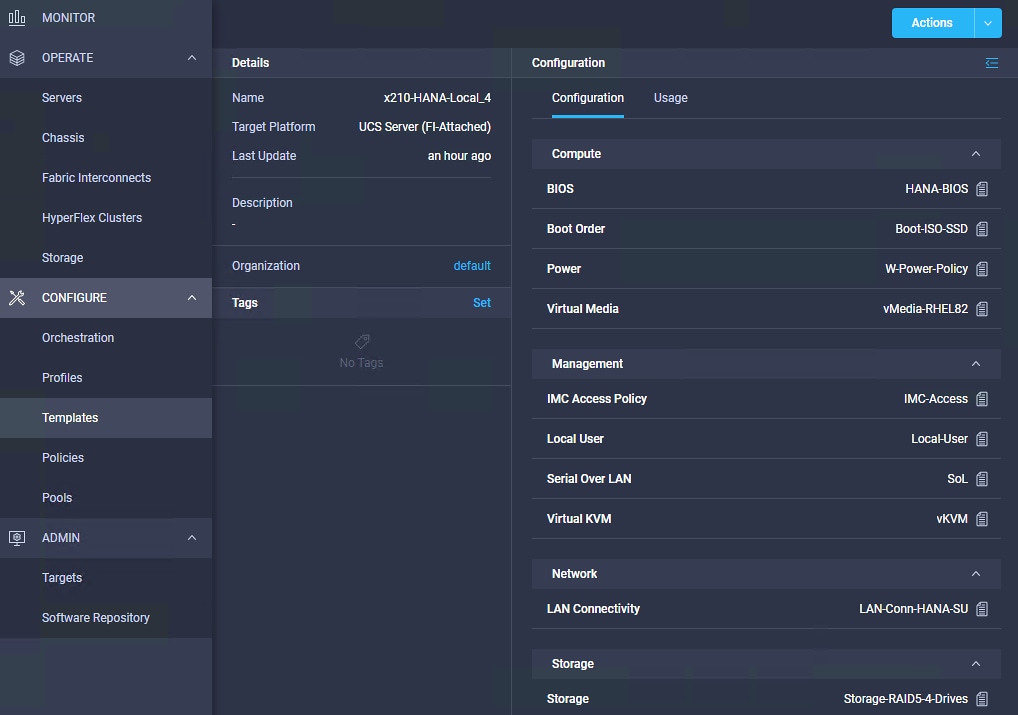
Derive and deploy server profiles from Cisco Intersight server profile template
The Cisco Intersight server profile allows server configurations to be deployed directly on the compute nodes based on polices defined in the server profile template. After a server profile template has been successfully created, server profiles can be derived from the template and associated with the Cisco UCS X210c M6 Compute Nodes, as shown in Figure 21.
Figure 21. Deriving a server profile from templates
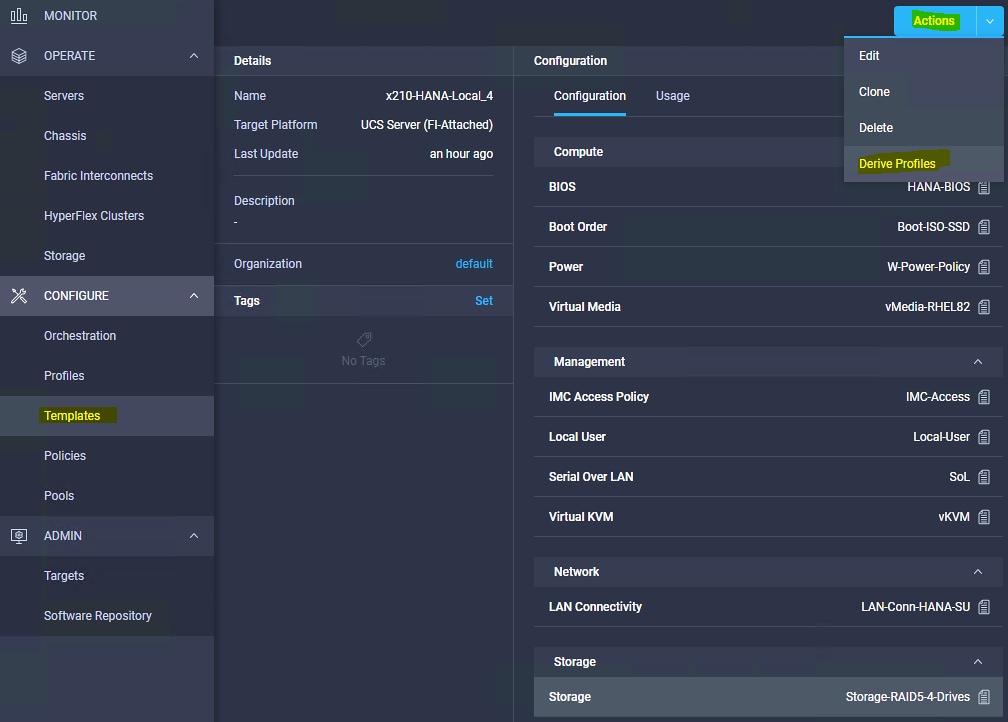
On successful deployment of the server profile, the Cisco UCS X210c M6 Compute Nodes are configured with parameters defined in the server profile and can boot from a RAID 5 system or, optionally, from the RAID 1 configured dual M.2 drives.
Solution validation: Hardware and software versions
Table 2 lists the hardware and software versions used during the validation of the solution described in this document. Note that the validated SAP HANA scale-up appliance solution explained in this document uses the Cisco interoperability matrix to determine support for various software and firmware versions. Customers can use the same interoperability matrix to determine support for components that are different from the current validated design.
Refer to the following link for the Cisco UCS Hardware and Software Interoperability Tool:
http://www.cisco.com/web/techdoc/ucs/interoperability/matrix/matrix.html.
Table 2. Hardware and software revisions
| Component |
Software |
|
| Compute |
Cisco UCS 6454 Fabric Interconnect and Cisco UCS 9108 25G IFM |
Release 4.2(1f) |
|
|
Cisco UCS X210C with Cisco UCS VIC 14425 |
Release 5.0(1b) |
Installing the operating system
This section provides an overview of the Linux operating system installation process. It includes OS customization–related SAP Notes you should apply to meet SAP HANA requirements.
SUSE Linux Enterprise Server for SAP Applications installation
SLES for SAP Applications is the reference platform for SAP software development. It is optimized for SAP applications such as SAP HANA. The SUSE documentation includes an installation quick-start guide that describes the installation workflow procedure. Consult the SLES for SAP Applications 15.0 Configuration Guide attached to SAP Note 1944799: SAP HANA Guidelines for SLES Operating System Installation, and follow the installation workflow.
The following supplemental SUSE information is available from the SAP Notes system:
● SAP Note 2369910: SAP Software on Linux: General Information
● SAP Note 2578899: SUSE Linux Enterprise Server 15: Installation Note
● SAP Note 2684254: SAP HANA DB: Recommended OS Settings for SLES 15 for SAP Applications 15
● SAP Note 1275776: Linux: Preparing SLES for SAP Environments
● SAP Note 2382421: Optimizing the Network Configuration on HANA- and OS-Level
Disable OS-based memory error monitoring
Linux supports two features related to error monitoring and logging: error detection and correction (EDAC) and machine-check event log (mcelog). Both are common in most recent Linux distributions. Cisco recommends disabling EDAC-based error collection, to allow all error reporting to be handled in firmware.
Disable EDAC by adding the kernel option edac_report=off. To add the kernel option, use the following command:
# yast bootloader
Mcelog is enabled by default in most recent Linux distributions, such as SLES for SAP Applications 15. For customers who prefer to collect all diagnostic and fault information from OS-resident tools, mcelog is recommended. Firmware logs may be incomplete when OS logging is enabled.
Red Hat Enterprise Linux for SAP Solutions installation
RHEL 8 introduces the concept of application streams. Multiple versions of user-space components are now delivered and updated more frequently than the core operating system packages. This change provides greater flexibility for customizing RHEL without affecting the underlying stability of the platform or specific deployments. Consult the RHEL 8 installation and configuration guide for instructions about how to download the appropriate RHEL for SAP Solutions installation image and follow the installation workflow. During the installation process, be sure to apply the best practices listed in SAP Note 2772999: Red Hat Enterprise Linux 8.x: Installation and Configuration.
The following supplemental RHEL information is available from the SAP Notes system:
● SAP Note 2369910: SAP Software on Linux: General Information
● SAP Note 2772999: Red Hat Enterprise Linux 8.x: Installation and Configuration
● SAP Note 2777782: SAP HANA DB: Recommended OS Settings for RHEL 8
● SAP Note 2886607: Linux: Running SAP Applications Compiled with GCC 9.x
● SAP Note 2382421: Optimizing the Network Configuration on HANA- and OS-Level
Disable OS-based memory-error monitoring
Linux supports two features related to error monitoring and logging: EDAC and mcelog. Both are common in most recent Linux distributions. Cisco recommends disabling EDAC-based error collection, to allow all error reporting to be handled in firmware.
EDAC can be disabled by adding the option edac_report=off to the kernel command line. Mcelog is enabled by default in most recent Linux distributions, such as RHEL 8.
For customers who prefer to collect all diagnostic and fault information from OS-resident tools, mcelog is recommended. In this case, Cisco recommends disabling corrected machine-check interrupt (CMCI) to prevent performance degradation. Firmware logs may be incomplete when OS logging is enabled.
All version-specific SAP installation and administration documentation is available from the SAP HANA Help portal: https://help.sap.com/hana. Refer to the official SAP documentation, which describes the various SAP HANA installation options.
Note: Review all relevant SAP Notes related to the SAP HANA installation for any recent changes.
SAP HANA Platform 2.0 scale-up system installation
The official SAP documentation describes in detail how to install the HANA software and its required components.
Download and extract the SAP HANA Platform 2.0 software to an installation subfolder of your choice. Follow the installation workflow of the SAP HANA Database Lifecycle Manager (hdblcm) and provide the user passwords when asked.
1. Change to the folder <installation path>/DATA_UNITS/HDB_LCM_Linux_X86_64.
2. Adapt the following command according to your SAP system ID (SID), SAP system number, host name, and required components:
# ./hdblcm --action install --components=server,client --install_hostagent \
--number <SAP System ID> --sapmnt=/hana/shared --sid=<SID> \
--hostname=<hostname> --certificates_hostmap=<hostname>=<map name>
3. Switch the user to <sid>adm to verify that SAP HANA is up and running:
# sapcontrol -nr <SAP System ID> -function GetProcessList
The Cisco solution for SAP HANA using the high-performance Cisco UCS X210c M6 Compute Node is well-suited for mission-critical business scenarios employing SAP HANA database management systems. The Cisco UCS X-Series server node delivers exceptional performance and is sized, configured, and deployed to match the SAP HANA appliance key performance metrics that SAP SE demands.
Also, with the introduction of the Cisco X-Series Modular System, SAP customers can now manage and orchestrate the next-generation Cisco UCS platform from the cloud using the Cisco Intersight platform.
This section includes links to various product pages.
Cisco UCS X210c M6 Compute Node data sheet
Cisco UCS X210c specifications sheet
Cisco Intersight platform: https://www.intersight.com
Cisco Intersight managed mode: https://www.cisco.com/c/en/us/td/docs/unified_computing/Intersight/b_Intersight_Managed_Mode_Configuration_Guide.html
Cisco Unified Computing System: http://www.cisco.com/en/US/products/ps10265/index.html
Cisco UCS 6400 Series Fabric Interconnects: https://www.cisco.com/c/en/us/products/collateral/servers-unified-computing/datasheet-c78-741116.html